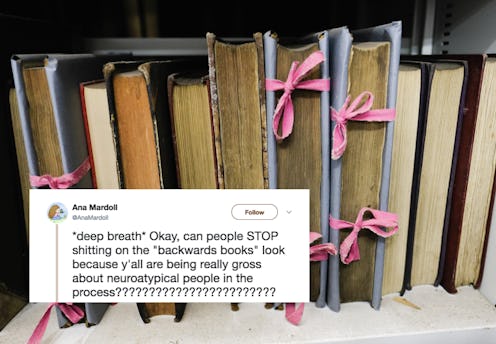Books
Shelving Books "Backwards" Has The Internet Divided, But It Could Have A Hidden Benefit
The first Instagram trend of 2018 has people turning books backward on their shelves for aesthetic purposes, and bibliophiles have a lot of feelings about it. The intention seems to be to leave books in keeping with a room's neutral tones, but for many people, this arrangement leaves a lot to be desired from a practicality standpoint. As a result, the backwards books trend has literary Twitter in an uproar, but it could have a hidden benefit you never thought about before.
Backward books have been a thing since at least 2014, when The Interior Collective reported on the trend, calling it "a brilliant idea" that works, so long as you "keep your most loved, most read books in a separate location." The controversy resurfaced in late 2017, when Apartment Therapy shared a photo of lifestyle blogger Carrie Waller's bookshelf on its Instagram feed with the caption: "Books don't match your decor? Don't fret. The incredibly easy solution? Flip them for a perfectly coordinated look."
There's no denying that Waller's bookshelf has an aesthetically pleasing quality about it. The aged book pages' neutral tones mix nicely with the whites, browns, and grays of the room. However, the idea of using books as nothing more than home-décor props struck a sour note with many readers, who argue that turning books backward would make it exceedingly difficult for many to navigate their own home libraries. As Apartment Therapy's Tess Wilson points out, identifying backward-facing books by their turned-out pages works best the fewer books you have:
I currently own about 35 tomes—not including my massive cookbook collection—and I could definitely recognize at least half of them if they were pages-out on the shelf. If I owned two or 10 times as many books, or if I were constantly adding to my collection, navigating backwards books would be completely impossible.
There's another side to this story, however, and it's an important one. Backward-facing books aren't just for neutral-obsessed hipsters with huge collections of Ikea furniture and Wes Anderson movies. The uncommon arrangement also helps some neuroatypical people from being overwhelmed by the clashing colors in their book collections, and can make home libraries populated with damaged paperbacks look better on the shelf.
Personally, I'm a fan of putting books in alphabetical order, but since a recent move, my books have been divided onto separate shelves for paperbacks and hardcovers, and have been arranged according to size, just because that was the quickest way to unpack my library. I haven't had a chance to re-sort my books yet, so I'm learning to live with a messy, but practical, arrangement. I guess what I'm trying to say is, just let people shelve their books the way they want, OK folks?
